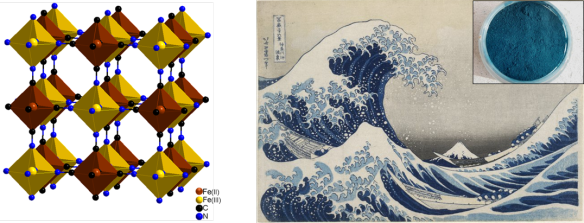Are you feeling blue? The structure of Prussian Blue
What is it?
In 1704, in Berlin, the colormaker Diesbach was working on the production of red pigment usually obtained by mixing iron sulphate and potash. Unfortunately for him, the potash he used had been contaminated with animal oil. In the result, instead of a strong red pigment, he got a deep blue! The potash had reacted with the animal oil (prepared from blood), to create potassium ferrocyanide, mixing this with the iron sulphate had created the chemical compound iron ferrocyanide, or Prussian blue. That way, he had accidentally created the first synthetic blue pigment!
Since, Prussian blue has been extensively used especially in painting like for example in the famous painting “The Great Wave off Kanagawa” of Hokusai Katsushika.
Structural analysis had revealed that the Prussian blue exhibits a cubic structure with mixed valence of Iron (containing both Fe(II) and Fe(III)). Each of the iron atoms has an octahedral environment coordinated axially and equatorially by a cyanide function.
What does it look like?

Left: The representation of the crystal structure of Prussian blue, this representation was generated using the Diamond software (http://www.crystalimpact.com/diamond/).
Right: Painting “Under the Wave off Kanagawa” by Hokusai Katsushika. Right inset: Prussian blue pigment, picture by Emmanuel Luc©.
Where did it come from?
The Prussian blue has been the focus of a lot of research by those investigating its composition, structure, color or even its magnetic properties and is still the subject of much research today. Its complete structure was reported for the first time by Buser (H. J. Buser, D. Schwarzenbach, W. Petter, A. Ludi Inorganic Chemistry, 1977, 16, 2107).






